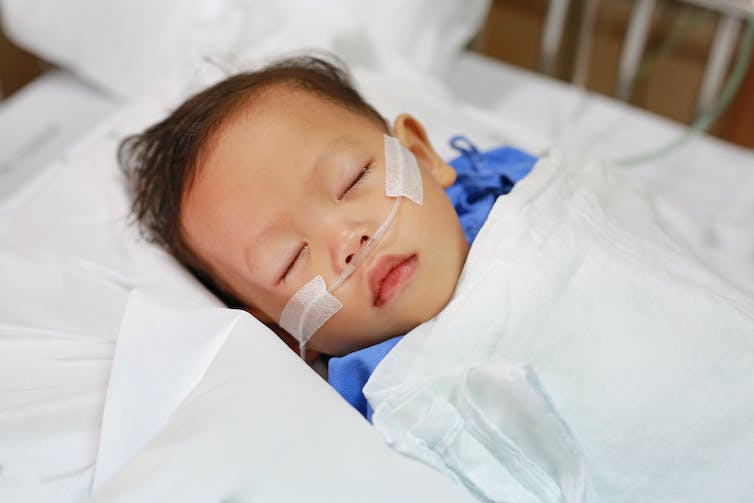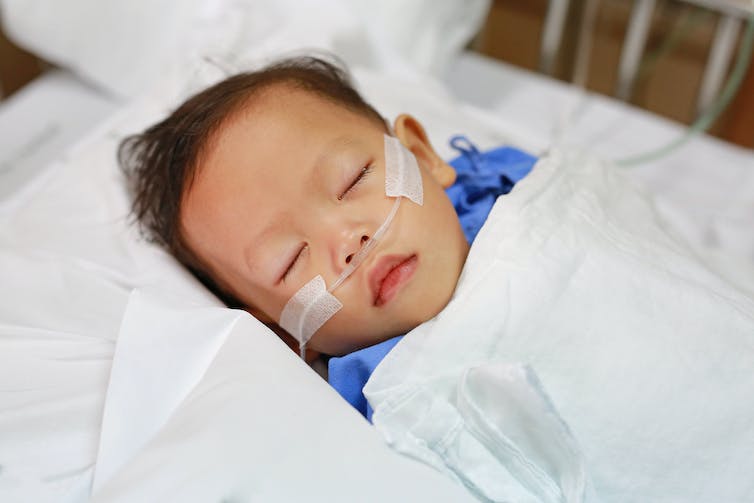At the peak of the pandemic, especially since 2021, many children and adolescents who were hospitalized had COVID. However, it was never clear what proportion of those who were hospitalized with COVID, presented with sufficiently severe disease, or for a different reason (such as an injury), but happened to test positive for COVID during admission.
The true rate of severe illness caused by COVID among those under 18 years of age continues to be debated by doctor and scientists. It was known from the start that severe illness in children was rare and more likely to occur in children with serious health problems such as chronic heart conditions or suppressed immune systems. But we don’t know how much age, poverty, or ethnicity is involved in disease severity.
Now we have some answers with the publication of our research in The BMJ where we looked at all children and adolescents hospitalized with the first recorded COVID infection in the UK between July 2020 and February 2022.
Of the 3.2 million children and young people in the UK with a first COVID infection during this period, nearly 30,000 were hospitalized.
We found that more than 70% of these children required hospitalization, in whole or in part, Because from COVID. Our study also shows increased vulnerability in the youngest children (especially those under one year of age), children from disadvantaged areas and children of ethnic minorities.
Some key findings
We’re part of a group of pediatricians and data scientists working together to study children’s health records. We categorize children’s hospitalizations into four groups:
- Admission with pediatric inflammatory multisystem syndrome (PIMS), a severe immune reaction occurs about four to six weeks after COVID infection.
- Admission due or suspected due to COVID, immediately after infection.
- Acknowledgment where COVID was part of the reason the child was hospitalized, among other factors.
- “Incident” hospital admissions where COVID did not play a role.
Of the 21,000 children who were hospitalized with COVID, suspected to be caused by COVID, partially due to COVID, or caused by STDs, 60% had no underlying health condition.
In contrast to the adult population, hospital-acquired COVID infection is rare, accounting for approximately 1% (380 cases), compared to approximately 30% in adults. This may be because most children stay in the hospital for a shorter time than adults, providing fewer opportunities for contracting COVID.
Overall, COVID stays in hospital were brief, indicating that most children recover quickly. Most children and adolescents are in the hospital between one and three days, although children with pims require a longer stay of about one week.
However, 12.4% of children (2,605 of 21,000) who were partially or completely treated for COVID had severe disease, as determined by the diagnosis of Pims (1,790 children) or those who did not require intensive Pims care (815 children).
Read more: COVID: long-term symptoms less common in children than adults – new research
Another difference compared to adults is that the proportion of children and adolescents who are hospitalized with COVID remains the same with the omicron variant. Among adults, the proportion in hospital primarily due to COVID decreased significantly with the arrival of the omicron in December 2021. On a positive note, in the era of the omicron, the number of children needing critical care decreased, at least in part due to fewer cases. Pim.
Children who are deprived are at higher risk
To understand more about risk factors for hospitalization, we looked at hospitalizations for COVID as a proportion of total infections, and compared them between different groups.
Total recorded infections were lower among children living in the poorest areas (625,000) than among the poorest (732,000). But specifically, there were more than twice as many COVID hospitalizations in the most disadvantaged areas (6,230 compared to 2,880).

GOLFX/Shutterstock
The lower number of infections recorded in poorer children means that fewer of them are being tested than children from wealthier areas. The higher number of hospitalizations in less able children may reflect greater exposure to infection but may also reflect a higher susceptibility to severe disease.
For example, children with obesity were more likely to be hospitalized than children who were infected but did not need hospital care. Children in poorer areas have significantly higher rates of obesity than children in less poor areas because of socioeconomic inequality.
We see a similar pattern for ethnicity, with ethnic minority children being overrepresented in COVID hospitalizations, especially in the most severe cases requiring critical care.
youngest children
The number of infections recorded in infants under one year of age was the lowest of any age group. This may be because they are less likely to get tested, but it may just be that they have less exposure to other people with COVID than older children who spend more time at school and kindergarten.
Nonetheless, and despite this group making up only 5% of all children under 18 years in the UK, infants account for 34% of all COVID hospitalizations (7,115 of 21,000).
Higher hospitalization rates in infants indicate that they are more vulnerable. Or they may appear more unwell and cause greater concern for parents and doctors when they get these infections than older children. It is known that children under one year old are more susceptible to other respiratory diseases such as RSV.
Read more: Six common COVID myths busted by virologists and public health experts
Unless babies over six months of age have certain underlying health conditions they are not offered COVID vaccinations in the UK. So we may see continued hospitalizations in this age group, who are not protected by previous infections or vaccinations.
Pregnant women are eligible for a COVID booster, and ensuring they receive this is important because their antibodies can protect newborns during the first few months of life.
#COVID #children #younger #children #disadvantaged #areas #higher #risk #hospitalization #research
